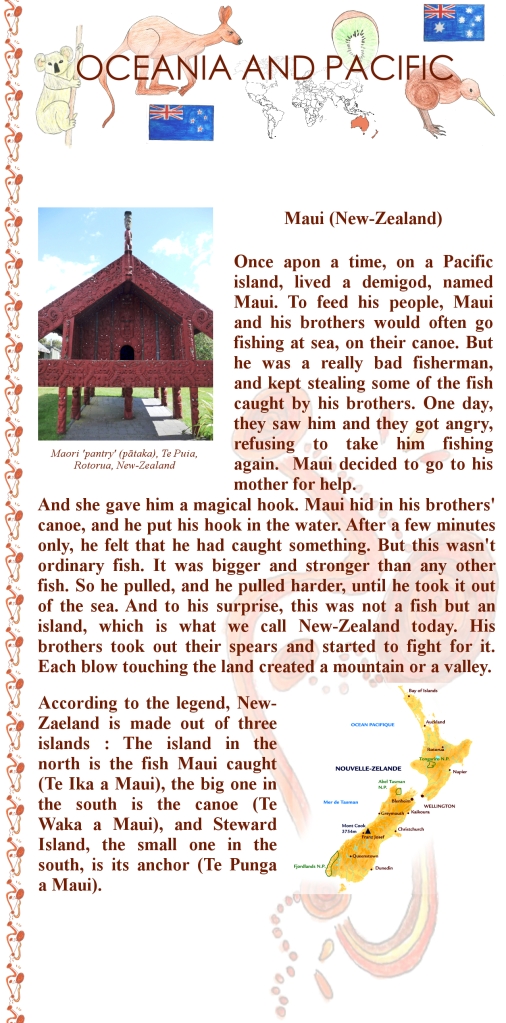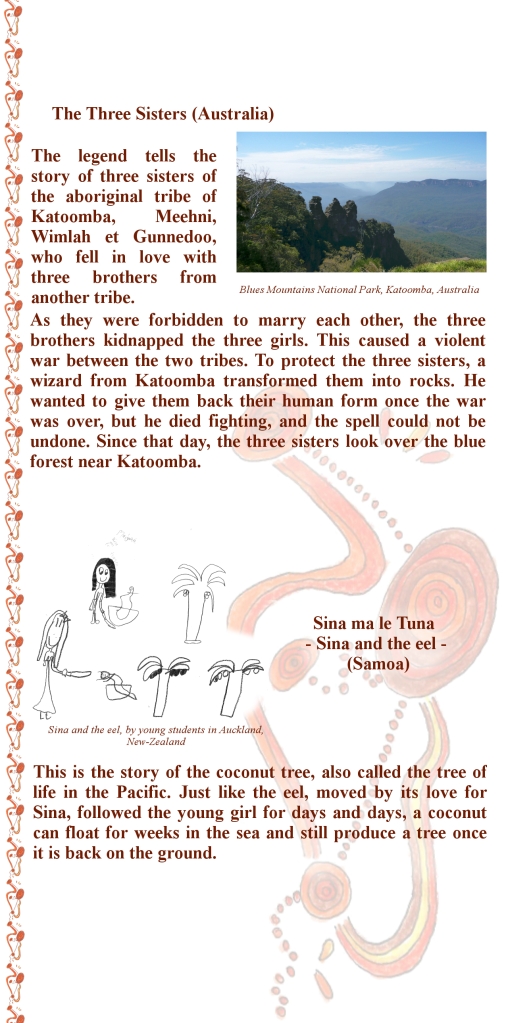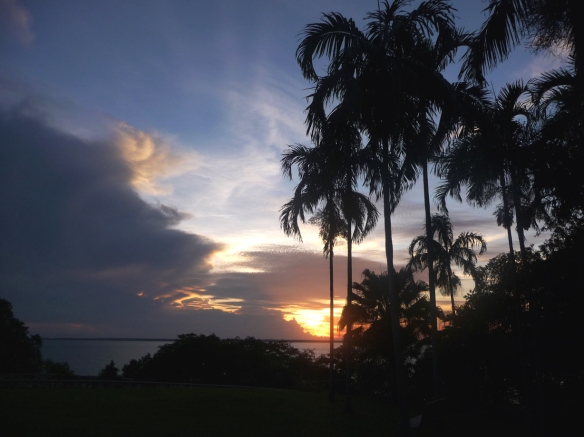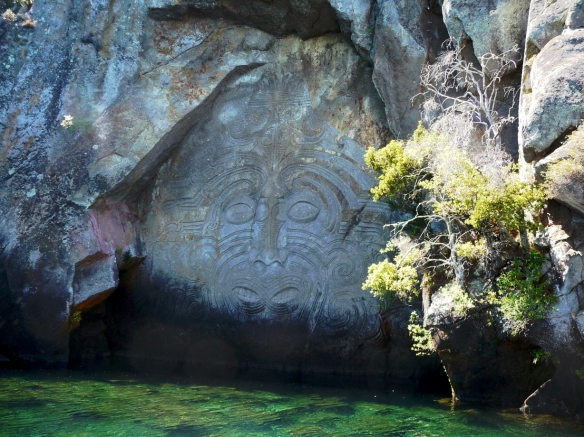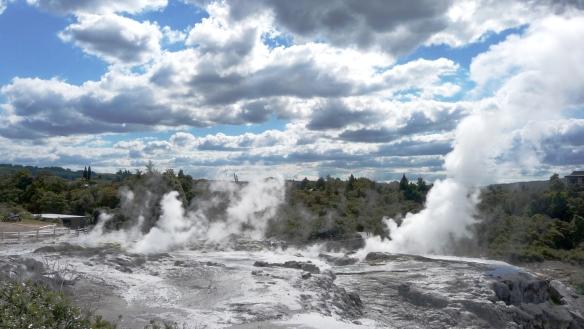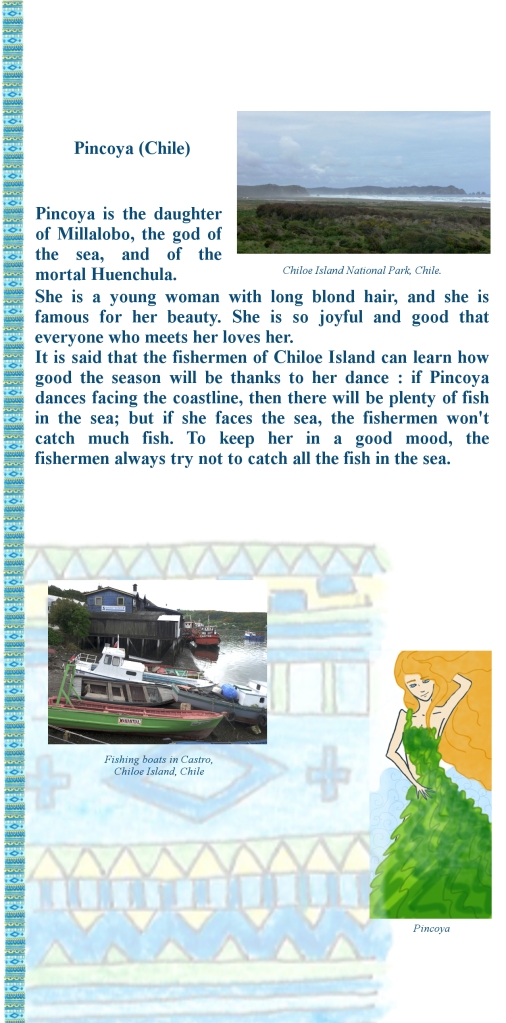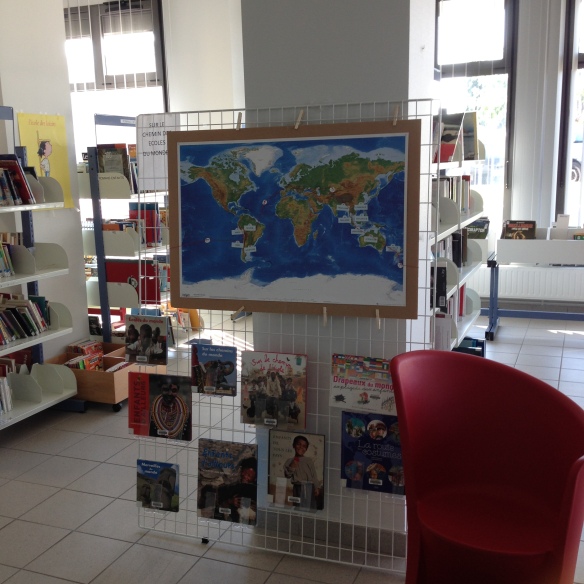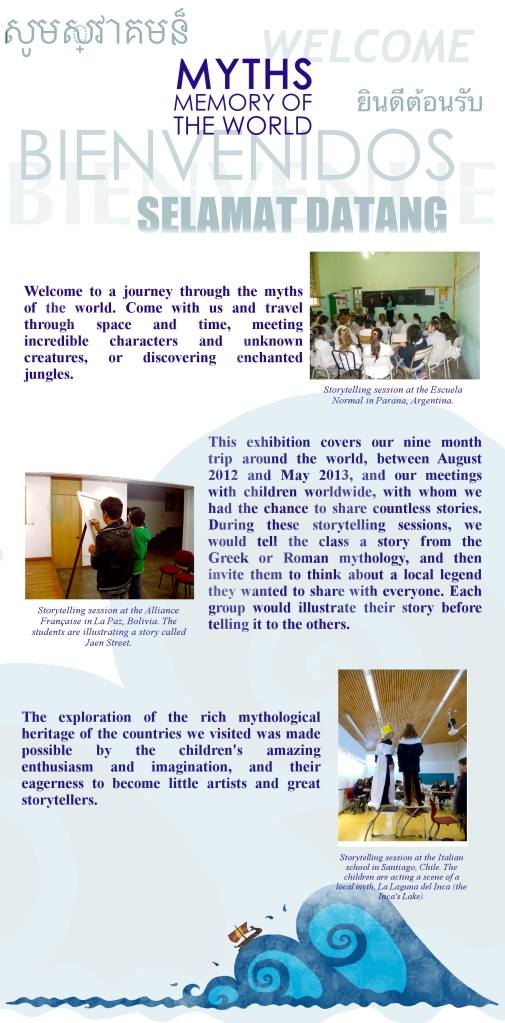A huge thank you to everyone who helped us make this project what it is, and mostly to all the enthusiastic children who participated, their teachers, and all of you who came to see this little exhibition. I hope you liked it!
Category Archives: presentation
The exhibition: Asia
The exhibition: Oceania and Pacific
The exhibition: South America
The exhibition: introduction
Just a word
Hello !
Well, I don’t have much to say about this last week… I am here mainly to let you know I’m going to take some time to deal with all the stories and material we’ve collected so far, so that I can finally share some of it with you. It will be online shortly!
I’ll be back soon, with some great myths and legends to tell!
Presentation #5: Auckland, NZ
First of all, I’d like to thank mrs. Stephanie Anish who let us come meet with the students of her school, and all the teachers who received us.
Monday, November 12th, we went to Richmond Road primary school, Posomby, Auckland. We were supposed to meet with two classes from the French section of the school, but thanks to Mrs. Vesna Nikolic-Ivanovic, the teacher I got in contact with, we were able to share our stories with young Maoris and Samoans too. Indeed, the school is made of 4 sections: Kiwi, Maori, Samoan and French (the last three are bilingual). It was truly a beautiful day, sharing beautiful tales among other things.
So, at 9:15am, first session with the seniors (aged 8 to 10) of the French section, to whom we told the myth of Orpheus and Eurydice.
Almost all of them knew the story, and they reacted very well to it: they were asking a lot of questions about it, trying to understand its meaning. Then, they started eagerly to draw their own stories. In this classroom, we listened to Perseus’ adventures (Well, Percy Jackson’s … I think we’ll have to watch that movie one day, as they all tell it to us), the tale of the three little piglets … In the end, their stories reminded us of the ones we hear back in France. However, a group told us the local story of Maui, which explains how the north island was born.
The next session took place in Vesna’s class, with younger children (aged 6/7). They were somewhat shyer, and knew less about mythology, but they appreciated the story of how Midas got donkey ears. It is a funny myth, and it made them laugh! The children would have chosen Apollo over Marsyas, of course, and most of them told us they couldn’t have kept the king’s secret either! As we only had an hour with them, unfortunately, we couldn’t listen to every group. Nonetheless, we heard the tales of Snow-White and Cinderella, another about a golden fish, and the story of Jesus’ resurrection.
Thanks to Vesna, who managed to organize everything for us in 15 minutes, we met a few students from the Maori section after lunchtime, for 45 minutes. It was brief, but really interesting and heart-warming, mostly because of the way the children listened carefully to our story, and were really excited about telling their own. So, I took of my shoes (they all walk barefoot inside – and outside), told them Orpheus’ tragic tale, and as we didn’t have much time, decided not to make them draw. Instead, they asked if they could reenact their myth and story to make them come to life. And we can say they did it well! The first one made us laugh by playing again Orpheus going down to the underworld and coming back, to lose Eurydice at the last moment. Then we watched and listened to an horror story (apparently real), and two maori myths. After this, the children insisted on doing a haka for us. I was really touched, even though I’m sure they just wanted to scare us! And let’s say it, it kind of worked. It is impressive, even danced by 9-year-olds.
[Interlude : Janyce did all the storytelling in the Maori and Samoan classes, while I shot a little video, or grabbed the drawings. Well, it was really impressive to see her surrounded by ten or fifteen children, all ears, mouth open, fascinated by the story. I was, too. Janyce managed to modulate her voice according to the drama, or put her own little touch to the story, adding funny or moving details to give more strength to imagination. She’s been a really good storyteller, and improved a lot from the beginning of this adventure around the world. You live, you learn!]
We had to go quickly afterwards, to be able to meet with the little Samoans before the school day ended. We were welcomed by a traditional song, and here again, the children listened to us with attention. Well, whatever we say, kids really enjoy listening to stories, that’s for sure (and that makes me happy)! However, it was harder for them to find a tale they wanted to tell. They knew some stories, but not well enough to tell them (they were really young, starting to learn how to read). But they had read a few Samoan myths, and with the help of their teacher, each group found a story and started illustrating it. This we discovered the stories of Lomi ma Lami, or of Sina and Tinilau. After the session, we talked a bit with the teacher, who told us she found the experience useful. I was really glad to hear her say that this made her realize that telling the story helps memorizing it: she will not only make them read, but also recite the stories they study, to remember the characters, the plot, and basically, what happens.
I am really sorry it took us so long to make that report, but it is really hard to get access to a computer in NZ and Australia, and Internet access is expensive here. But here it is!
Soon, you’ll get news a bit more often, once we get to Asia!
Fourth Presentation in Santiago del Chile
Session 1
When : 16th October 2012
Where: Santiago del Chile, at Scuola Italiana Vittorio Montiglio
Level : 6A, 6B (Teacher Angela Bortoluzzi)
Age of the children : between 11 and 12 years old
Number of children : nearly 19-22 per class
Number of stories told : 4 per class
;
Session 2
When : 17th October 2012
Where: Santiago del Cile, at Scuola Italiana Vittorio Montiglio
Level : 6C (Teacher Barbara Bucci)
Age of the children : between 11 and 12 years old
Number of children : nearly 20
Number of stories told : 4
;
Last 16th and 17th October in Santiago, we had the opportunity to give three mythological lessons at the Scuola Italiana Vittorio Montiglio, situated on the top of a hill in Las Condes where you can see all the city in its splendour (and heavy sky). The building of the school is pretty new and beautiful – it represents the educational mission leaded by the Scuola Italiana : a place open to cultural exchanges, open to the wind and new opportunities. The pupils can attend to different talleres, learning to cook or taking photograpy lessons or playing music in a band. Really interesting! Janyce and I wished we could be teenagers again, so that we could go to that wonderful school (yet, the thought of tons of homework readily dissipated our transient nostalgia)…
Anyway, let’s talk of those two very busy october days.
The first presentation took place at 8 o’clock in the morning (well, we were a bit late, shame on us! let’s say 8h15), till almost ten o’ clock. The children had previously done some research with their main teacher and also prepared amazing masks with their art teacher, in order to play the myth they had chosen to tell. The myths were classified by their provenience : we first had myths from the North of Chile, then the center, and finally, on the second day, Mapuche legends and from the Chiloe Island, in the south of Chile. Hence, it was an interdisciplinary project and the children would receive a mark for their work and play.
I chose to tell three myths : the foundation of Rome, the misadventure of Ulysses with Polyphemus and the metamorphosis of Arachne, as told by Ovid and translated by Janyce Desiderio from the latin. As the presentation was to be done in italian, Janyce was in charge of the camera (and she did it perfectly). Since the children had already some notions of Greek and Latin mythology, instead of doing our basic introduction to Classic culture, I asked the children what they knew about the Ancient Roman and Greeks, what they thought about telling stories, and why is it so important to preserve those stories, or to have a story to tell… Most of the answers given where really interesting.
At the end of the legend of Romulus and Remus, one of the pupils, maybe the most very participative in the 6B, Flavio, did a very good and clever remark, (although it was problematic from the mere point of view of chronology) : he compared the story with the Book of the Jungle (a child raised by wolves) and with an episode of the Ancient Testament, Moise (a child thrown into a river on a frail basket and saved by miracle). It was such a nice surprise!
the four stories told and acted by the pupils of the 6B were the following :
1) El Alicanto Catacama
2) Los Sobavanas de Pica
3) Juan Soldado
4) La Cueva
The tricks of Ulysses against of Polyphemus made the second class laugh, and we began to discuss together some notions of morality : which is the aim of this story? Who was wrong? What do we learn about the mistakes of each one of the protagonists? I could then introduce very briefly the notion of hybris, fundamental in the greek culture.
1) Make Make
2) Aku Aku
3) Carpancho
4) La Coca
In the third class, we discovered that they already knew the myth of Arachne, so I asked at the end, always about the hybris concept : what happens when humans defy the gods? Are the gods wiser than humans in greek mythology? The children were a bit shier than those in the previous classes
1) La Llorona
2) El Tué Tué
3) La Pincoya
4) El Trauco
;
Third Presentation in La Paz
Session 1 :
When : Wednesday, 26th September 2012
Where : Alliance française, La Paz, Bolivia
Level : 1e et 2ème années de français
Pupils : 28
Lenght : 1h30
Telling the story of : Dedalos and the labyrinth
Stories told by the teenagers : 8
Session 2 :
When : Thursday, 27th September 2012
Where : Alliance française, La Paz, Bolivia
Level : 3e et 4e années de français
Pupils : between 15 and 20
Lenght : 1h30
Telling the story of : the foundation of Rome
Stories told by the teenagers : 6
On the last days of September, we realized two mythological presentations at the Alliance Francaise in La Paz, Bolivia. The first group was constituted of teenager students between 13 and 16 years old beginning their studies in French, while the second one included students between 13-14 years old with four years of french studies already done.
Although we were not used to deal with teenagers, both groups were very participative, and we collected many interesting traditional stories of Bolivia, mostly told in french, and sometimes finished in spanish. For the first one, it was a bit difficult at first to tell the story with simpler words, especially for the most complicated parts of the myth of Dedalus, trying to get them more clearly articulated, stopping from time to time to check if they had understood the main plot of the drama. Fortunately, the beautiful fresque painted by Janyce helped a lot in figuring the main parts off, and we had previously written down on the board the names of the characters, so that it would be easier to associate the sounds with their complicated french orthography.
The teenagers were all very shy, and wouldn’t talk easily at first, or ask questions about the story : yet, once involved in their own story to tell, they tried their best to speak in french, some of them with the help of their teacher, some others using the board to illustrate chosen scenes. One of the girl told us a beautiful moral story about bearing pain and sufferance of life, as they tell it in her family, while others told us about the legends of some streets of La Paz, Potosi or Oruro.
Later on, talking with the teachers about this experience, we received a lot of useful pieces of advice to apply in the future, especially for beginners in French : stopping from time to time and asking what’s going on for the storytelling, making smaller groups of two or three so they can discuss the meaning of the story heard before they speak out loud, trying to articulate and talk very slow in French… we shall keep them in memory for sure!
The second group, the next day, was even shier at first, but the teenagers got very interested by the story of the foundation of Rome : who was right, Remus or Romulus? Why did Romulus kill Remus? They diligently copied the genealogy of the alban kings that Janyce had written on the board, then began to ask little questions about Rome, the she-wolf, the shepherds Faustulus and Acca Larentia, if there were still Monsters in France… They seemed to understand well the story, and then began to work in little groups to tell their own legends. And this time we didn’t forget to add a significant conclusion, asking them to answer to some questions : why do we tell stories? what’s the use of legends? why do we have different versions of the same story?
One group even chose to tell a greek myth, the tragic yet beautiful story of Orpheus and Eurydice… surprising!
The teenagers were sometimes shy, sometimes funny, polite or distant, at first difficult to approach : however, their participation really enjoyed us and helped us in collecting traditional Bolivian myths!
For the drawings and a first transcription of the stories told by the teenagers af La Paz (in French), please look here. Enjoy!
Welcome to Paraná (myths, baguette and much more)
When : Tuesday 4th September 2012
Where : Escuela Normal, Paraná, Entre Ríos, Argentina
Level : 4e, 5e et 6e grades
Number of pupils : 35
Lenght of the session : 1h40
Chosen myth : Midas and the golden touch
Number of stories told by children: 6
After one week of (relative) calm holidays in Misiones, we finally moved towards Paraná to meet our first class in Argentina. We traveled by night and arrived a little late at the bus station (seven o’clock in the morning, instead of six and forty), because the Police stopped our car for a routine check of the passengers : Carina, Brenda and German were already waiting for us in the cold and kindly welcomed us.
After a swift and delicious breakfast, we went to explore the nice park by the Río Paraná, while Carina and Brenda had to attend to a reunion of the teachers at the Normal School. In the afternoon, we were invited by Brenda in a class of the Alliance Francaise in Paraná to chat a bit in french and answer to the question of the students, mostly adults. It was very nice and interesting to discover how they saw France, the French, and of course French cuisine. The students were rather shy in our presence and wouldn’t talk much in french, although they seemed very curious, so we had to alternate between a more clearly articulated french and our wonderful spanish.
A little while after, we met the directors of the Alliance Francaise and of the Normal School, both very welcoming and enthusiast about the project we were leading, and then had a coffee and biscuits with the french teachers of the school and their assistants : we talked about France, education in Argentina and the french dream, the hard role of the teachers, and a bit of history and politics, all very thought-provoking.
This first day was intense and full of new acquaitances, yet the next day would be far more busy and challenging.
On the 4th September, we had to expose briefly the greek and latin world and tell the story of Midas, the (stupid) king that changed everything into gold by touching it, to a class of 35 children between 8 and 12 years old. Carina had carefully organised everything for us, yet there was a surprise in the morning. On our way to school, Brenda received a call on her cellphone from Carina, saying that the local radio wanted to interview us by phone, to speak about our project, Paris and Buenos Aires. Argh! I hope that my spanish wasn’t too horrible. Brenda and Janyce were so stressed for me that they kept petting Aphrodite and Mister Persident, the beautiful dog and proud cat of Brenda, to calm down. Fortunately, they didn’t saw me blush from head to feet at the phone.
Once in the school, while waiting for the class to begin, the reporter of the school paper did just in time to interview us and take some photos before we were called in. And then, all the eyes were pointed on us. The children were seated in a semi-circle, curious and excited. We did a brief introduction of the Classic culture in french and spanish (a boy kept laughing while we were speaking), and then told the myth of Midas, trying to speak loud and clear, making gestures and showing Janyce’s drawings. At the end of the story, we discovered that the children had found it very difficult to follow in french and understand the drama. So, we decided to repeat the myth more slowly, with simpler words, asking what they had understood and trying to explain the more complex passages in spanish (fortunately, the other teachers helped us very quickly). Some of them already knew the myth and began to tell it to those who hadn’t figured out the main details.
Came the time in which the children had to draw chosen scenes of the story they would tell a little after, and it was very interesting to compare their behaviour with the french pupils we met in Saint-Romain : they were more lively and excited, not to say more loud or expansive, and more prone to work in little groups with friends. Yet, there was still the lonely wolf working by himself, very shy and secretive. We passed among the table to help them finding out stories, but often they would come to us to ask little questions in french (what’s your name? When is your birthday? Do you like mate?). It was not easy to advise them or to keep a certain order, and the teachers have been very helpful. It was funny to observe the implication of every child in the teamwork, and their good will (some of them tried to cheat for the drawing of a dragon). When the storytelling time began, we already had volunteers : however, once in front of the class, the children became very shy, not knowing really how to tell well the story. Some of them were interrupted by the public, when the story didn’t appeal, some received suggestions or corrections from it, when the story was well-known, while others chose to invent or reinterpret a story or a myth : we thus could hear the Little Red Riding Hood, The Ugly Duckling and a story of princess and dragon, mostly of european tradition. One of them told the strange story of the Minotaur, but a very personal one : one day the ugly monster fell again and again, and when he got up, he was beautiful. Only one group told us the inca legend of Cacheute, although they pretty most read it to the class, while another tried to tell the argentinian tale of the Elephant Dailankifki, but was interrupted. Even the most shy girls in the class came to tell a story, and the children didn’t ask to go out, although it was a very long lesson (normally, they use to have 40 mn of class, and we kept them almost for 2 hours). Halas, due to a lack of time, few groups couldn’t pass and we have now to guess the stories with their drawing (one is suspected to illustrate Dragon Ball Z). They were all very cute. As Brenda pointed it out, children sometimes used a particular language to expose the stories, traditional formulas that they never use in every-day speech. The drawings of the children shall be the main material of a following post. We hadn’t the authorizations to shoot a video with the children, but we have recorded the stories so to write them down as soon as possible. It is true that we have heard only one local tale, Cacheuta, but we must consider that those children are raised in a society impregned by european values and conceptions. I think we should have different results if we could meet indian children. However, it is interesting to note which stories are the most popular, and how children can use the archetypes of the tales to make up one of their own.
At the end of the class, the journalist of El Diario came for an interview, and we told us our first impressions with the children. All this in spanish, of course, but somehow we worked it out. Carina had also scheduled for us a live interview in a local tv program in the afternoon, and oh gosh, this was a stressing experience!
After our exceptional performance at the telly (cof cof), we went to speak to a class of young adults in the Business School of Paraná and chat again about Paris, France (yes, I assure you, French people wash themselves daily – well, almost- and don’t make strong parfums to cover a bad smell), Parisian architecture and talk about the radio project they had to lead about France. Some of them were quite impertinent, some other very interested, and above all, very curious and welcoming.
This busy and eventful day came finally to an end, and Brenda and German prepared a typical and delicious dish of Paraná, the chupin ; then we played ukulele and sang till early hours with German and Jimen, her talented niece who plays Murga-like music.
And next day, Carina brought us a surprise : we were on the front page of El Diario!
Our staying at Paraná has been very stimulating and rich of humanity. It was really heartwarming to see that our project made the children and the teachers so enthusiast. Moreover, we are grateful to Carina for her kind and generous welcome and very neat organisation, and to Brenda and German for hosting us, letting us taste the best argentinian specialities (wine, beer, alfajores santafesinos, mate, tortas fritas), telling us popular tales about food and siesta (we shall soon tell you about the dreadful Solapa, who takes away in his bag the naughty children that don’t respect the siesta time) and giving us contacts to continue our travel.
Muchas Gracias!








